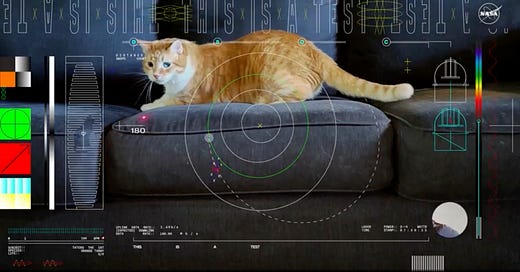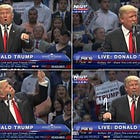What NASA’s award-winning content strategy can tell us about building support for government
Plus: This graphic designer won $1 million from Elon Musk. Her story’s changed.
What NASA’s award-winning content strategy can tell us about building support for government
To demonstrate the remarkable streaming capabilities of its Deep Space Optical Communications project in 2023, NASA beamed a cat video back to Earth from nearly 19 million miles away.
A 15-second video of an orange tabby cat named Taters chasing a laser pointer was streamed to Earth from Psyche, a spacecraft launched earlier that year that’s headed to study a metal-rich asteroid in the asteroid belt and had the video on board. It beamed the video back home from its location in a speedy 101 seconds.
The mission of NASA's Deep Space Optical Communications project is to build higher-data-rate communications that will one day be capable of sending messages, images, and video between Earth and Mars. By testing it with one of the internet’s favorite forms of content, a cat video, NASA drew more attention to the project than it otherwise would have received. The video reached 451 million people online, according to NASA, and it’s now one of the agency’s 10 nominations for this year’s Webby Awards, a contest for the best of the internet.
As President Donald Trump’s administration guts federal agencies, NASA’s impressive content machine is a reminder of the value of storytelling in building public support for government. To DOGE and its supporters, government is bloated and the civil servants who do the work of keeping it running are numbers on a spreadsheet that can be cut. A compelling content strategy, though, could help combat that impulse by educating and informing the public about the value government delivers to its citizens.

NASA has won 28 Webby Awards going back to 1998, when Starchild, an educational website to teach kids ages 5 to 13 about the solar system and the Milky Way galaxy, won the agency’s first award. This year, NASA’s nominees include its campaign for last April’s solar eclipse, which brought in about 40 million livestream views, and its weekly newsletter, which has more than 5 million subscribers.
NASA’s Instagram account is closing in on 100 million followers — more than the combined follower counts of the president’s personal and government Instagram accounts — and it’s up against a fellow government agency, the U.S. Fish and Wildlife Service, as well as National Geographic and other nominees for an award for General Social, Education & Science.
“The 2025 Webby nominations demonstrate NASA's dedication to sharing the wonders of space through digital platforms,” NASA’s deputy associate administrator for communications Michelle Jones said in a statement. “We believe in the power of digital storytelling to inspire the next generation of explorers.”
The awards are nice, but NASA sees digital content as part of its mission. “Since it began in 1958, NASA has been charged by law with spreading the word about its work to the widest extent practicable,” the agency said in a press release announcing the nominations. “From typewritten press releases to analog photos and film, the agency has effectively moved into social media and other online communications.”
NASA today is popular and beloved, but it hasn’t always been that way. In 1979 for the 10-year anniversary of the moon landing, an NBC News-Associated Press poll found a 53% majority of Americans thought the U.S. space program’s costs weren’t justifiable. Support for NASA has since grown, though, and having an uber popular Instagram account and a resurgence of NASA nostalgia surely hasn’t hurt. A 2023 Pew Research Center survey found 69% of U.S. adults believed it was “essential” that the U.S. “continue to be a world leader in space exploration,” helpful as the agency looks to return to the moon and beyond.
Astronauts are inherently cool, space is inherently awe-inspiring, and NASA is inherently design-forward, thus America’s national space agency benefits from being the Bugatti of government agencies. Still, for communicators working in less sexy branches of federal, state, and local government, there are important lessons for how to rally the public together behind your cause and communicate your mission.
What was once seen as an expensive government program now enjoys broad support thanks in part to a communications strategy that seeks to bring outer space closer to home and makes it feel both accessible and exciting. NASA’s digital storytelling skills aren’t just award winning, they’ve helped shape public perception of the agency itself.
Sometimes, this press release could have been a cat video.
Previously in YELLO:
This graphic designer won $1 million from Elon Musk. Her story’s changed.
Graphic design is not for the faint of heart. Clients constantly want you to make the logo bigger, Canva convinced amateurs they don’t need to hire professionals, and the threat posed by artificial intelligence can feel existential. One graphic designer from Wisconsin, though, showed an easy way to make some extra cash: enter Elon Musk’s misbegotten sweepstakes to try and sway a statewide election.







